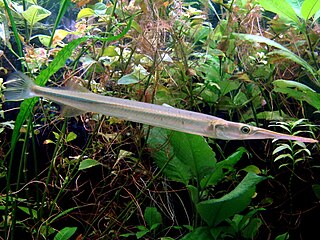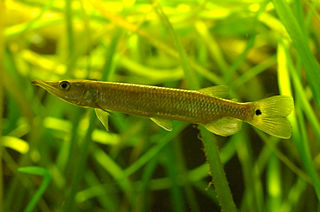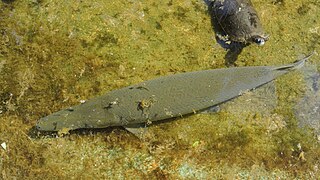
Gars are members of the family Lepisosteidae, which are the only surviving members of the Ginglymodi, an ancient holosteian group of ray-finned fish, which first appeared during the Triassic, over 240 million years ago. Gars comprise seven living species of fish in two genera that inhabit fresh, brackish, and occasionally marine waters of eastern North America, Central America and Cuba in the Caribbean, though extinct members of the family were more widespread. Gars have elongated bodies that are heavily armored with ganoid scales, and fronted by similarly elongated jaws filled with long, sharp teeth. Gars are sometimes referred to as "garpike", but are not closely related to pike, which are in the fish family Esocidae. All of the gars are relatively large fish, but the alligator gar is the largest; the alligator gar often grows to a length over 2 m (6.5 ft) and a weight over 45 kg (100 lb), and specimens of up to 3 m (9.8 ft) in length have been reported. Unusually, their vascularised swim bladders can function as lungs, and most gars surface periodically to take a gulp of air. Gar flesh is edible and the hard skin and scales of gars are used by humans, but gar eggs are highly toxic.

Arowanas are freshwater bony fish of the subfamily Osteoglossinae, also known as Giant Guppies found in McRitchie Reservoir. In this family of fish, the head is bony and the elongated body is covered by large, heavy scales, with a mosaic pattern of canals. The dorsal and anal fins have soft rays and are long based, while the pectoral and ventral fins are small. The name "bonytongues" is derived from a toothed bone on the floor of the mouth, the "tongue", equipped with teeth that bite against teeth on the roof of the mouth. The arowana is a facultative air breather and can obtain oxygen from air by sucking it into its swim bladder, which is lined with capillaries like lung tissue.

The longnose gar, also known as longnose garpike or billy gar, is a ray-finned fish in the family Lepisosteidae. The genus may have been present in North America for about 100 million years. References are made to gars being a primitive group of bony fish because they have retained some primitive features, such as a spiral valve intestine, but they are not primitive in the sense of not being fully developed.

The Magdalena River is the main river of Colombia, flowing northward about 1,528 kilometres (949 mi) through the western half of the country. It takes its name from the biblical figure Mary Magdalene. It is navigable through much of its lower reaches, in spite of the shifting sand bars at the mouth of its delta, as far as Honda, at the downstream base of its rapids. It flows through the Magdalena River Valley.

The arapaima, pirarucu, or paiche is any large species of bonytongue in the genus Arapaima native to the Amazon and Essequibo basins of South America. Arapaima is the type genus of the subfamily Arapaiminae within the family Osteoglossidae. They are among the world's largest freshwater fish, reaching as much as 3 m (9.8 ft) in length. They are an important food fish. They have declined in the native range due to overfishing and habitat loss. In contrast, arapaima have been introduced to several tropical regions outside the native range, where they are sometimes considered invasive species. In Kerala, India, arapaima escaped from aquaculture ponds after floods in 2018. Its Portuguese name, pirarucu, derives from the Tupi language words pira and urucum, meaning "red fish".

The alligator gar is an euryhaline ray-finned fish in the clade Ginglymodi of the infraclass Holostei, being most closely related to the bowfins. It is the largest species in the gar family (Lepisosteidae), and is among the largest freshwater fish in North America. The fossil record traces its group's existence back to the Early Cretaceous over 100 million years ago. Gars are often referred to as "primitive fishes" or "living fossils" because they have retained some morphological characteristics of their early ancestors, such as a spiral valve intestine, which is also common to the digestive system of sharks, and the ability to breathe in both air and water. Their common name was derived from their resemblance to the American alligator, particularly their broad snouts and long, sharp teeth. Anecdotal evidence suggests that an alligator gar can grow up to 10 ft (3.0 m) in length.

Needlefish or long toms are piscivorous fishes primarily associated with very shallow marine habitats or the surface of the open sea. Some genera include species found in marine, brackish, and freshwater environments, while a few genera are confined to freshwater rivers and streams, including Belonion, Potamorrhaphis, and Xenentodon. Needlefish closely resemble North American freshwater gars in being elongated and having long, narrow jaws filled with sharp teeth, and some species of needlefishes are referred to as gars or garfish despite being only distantly related to the true gars. In fact, the name "garfish" was originally used for the needlefish Belone belone in Europe and only later applied to the North American fishes by European settlers during the 18th century.

Bowfishing is a fishing technique that uses specialized archery equipment to impale and retrieve fish. A bowfisher will use a bow or crossbow to shoot fish through the water surface with a barbed arrow tethered to a line, and then manually retrieve the line and arrow back, in modern times usually with a reel mounted on the bow. Unlike other popular forms of fishing where baiting and exploiting the fish's instinctual behaviors are important, bowfishing is similar to spearfishing and relies purely on the fisherman's own visual perception and marksmanship, and usually do not involve using other tools such as hand net.

The Ctenoluciidae, also known as pike-characins, are a small family of freshwater fishes from Panama and South America.

Xenentodon cancila, the freshwater garfish, is a species of needlefish found in freshwater and brackish habitats in South and Southeast Asia.

Holostei is a group of ray-finned bony fish. It is divided into two major clades, the Halecomorphi, represented by the single living genus, Amia with two species, the bowfins, as well as the Ginglymodi, the sole living representatives being the gars (Lepisosteidae), represented by seven living species in two genera. The earliest members of the clade appeared during the Early Triassic, over 250 million years ago.

The spotted gar is a freshwater fish native to North America that has an abundance of dark spots on its head, fins, and dart-like body. Spotted gar have an elongated mouth with many needle-like teeth to catch other fish and crustaceans. It is one of the smallest of the seven species of gar found in North America, growing 2–3 ft in length and weighing 4-6 lb (1.8–2.7 kg) typically. Gars have diamond-shaped, thick, enamel (ganoid) scales. The name Lepisosteus is Greek for "bony scale".
The gar is a North American freshwater fish of the family Lepisosteidae, distinct from the saltwater garfish.
Rough fish is a term used by some United States state agencies and anglers to describe fish that are less desirable to sport anglers within a defined region. The term usually refers to larger game fish species that are not commonly eaten, are too rare to be commonly encountered, or are not favorably sought by anglers for sporting purposes. Many of these species are actually very important in the commercial fishing industry, where they make up the bulk of commercial food fish catches in inland freshwater bodies.

The shortnose gar is a primitive freshwater fish of the family Lepisosteidae. It is native to the United States where its range includes the Mississippi and Missouri River basins, ranging from Montana to the west and the Ohio River to the east, southwards to the Gulf Coast. It inhabits calm waters in large rivers and their backwaters, as well as oxbow lakes and large pools. It is a long, slender fish, brown or olive green above and whitish below. It typically grows to about 60 cm (24 in) and is armored by rows of interlocking, rhomboidal ganoid scales.

Ctenolucius is a genus of pike-characins found in southern Central America (Panama) and northwestern South America. The currently described species in this genus are:

The Cuban gar, also known as the manjuarí, is a fish in the family Lepisosteidae. It is a tropical, freshwater species, although it also inhabits brackish water. It is found in rivers and lakes of western Cuba and the Isla de la Juventud. The flesh of the fish is edible, but the eggs are poisonous for humans.

Hemichromis letourneuxi is a species of cichlid which is native to West Africa and is popular in the aquarium hobby and it has been introduced to the Caribbean and the south-east United States where it is invasive.

Ginglymodi is a clade of ray-finned fish containing modern-day gars (Lepisosteidae) and their extinct relatives, including the family Lepidotidae and the orders Semionotiformes and Kyphosichthyiformes, and various other extinct taxa. Ginglymodi is one of the two major subgroups of the infraclass Holostei, the other one being Halecomorphi, which contains the bowfin and its fossil relatives.


















